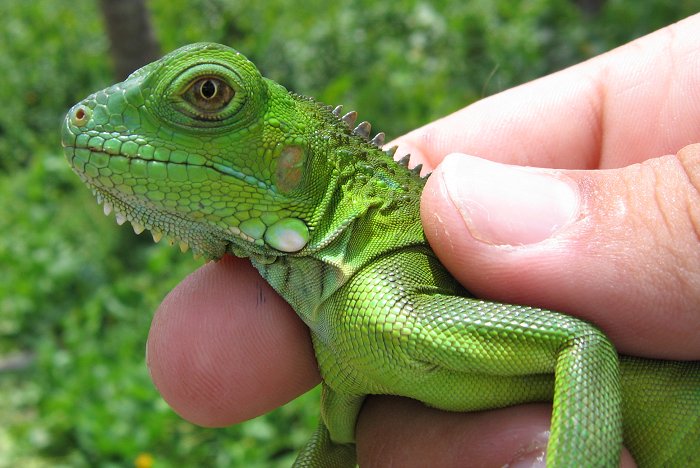 Baby Green Iguana – Interesting Informations About The Baby Green Iguana
Baby Green Iguana – Interesting Informations About The Baby Green Iguana
The green iguana is one kind of reptile which is commonly found all throughout South and Central America. The breeds of the green iguana are also spotted in Mexico, Paraguay, Brazil, and the Caribbean Islands. There is no definite proof that the green iguana ranks among the endangered animals but then it is sometimes misconstrued to be one because it is a major attraction to the hunters. Hunters love to capture the big female iguanas. The green iguana is also a favorite delicacy of some and it is known by the name of “Bamboo Chicken”.
The Physical Appearance of the Green Iguana
The overly grown green iguanas typically grow in between four and six feet but there are some that extend up to seven feet. The tail takes up almost all of the length since it ranks to be almost half of the entire body measurement. Despite their being green, there is likewise the dominant black stripe coloring in its body. Not because they are called green iguanas they will already settle for the monochromatic color of green. The shade also diverts from the very bright green to the grayish and dull green. The skin of the green iguana is mostly rough primarily because of the pointy scales along the animal’s back. The green iguanas are equipped with claws and long fingers so that they can easily grasp and climb.
The Habitat of the Green Iguana
Baby green iguanas are typically raised in the tropical rainforest areas specifically in areas with lower altitudes and accessible water resources like those of the streams and rivers. Most of their formative years are confined in the forest top at about forty up to fifty feet high atop the ground.
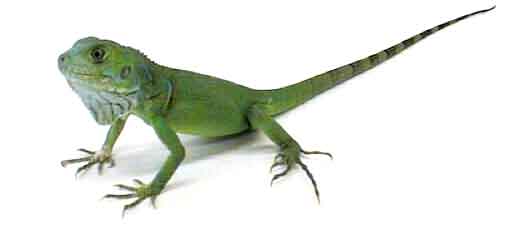
The Admirable Adaptations of the Baby Green Iguanas
Aside from the invariable claws and long fingers possessed by the baby green iguanas, they also have a lot of proficient and admirable adaptations with them. The baby green iguanas are keen in terms of their senses of hearing, sight, and smell. One of their defense mechanisms is their tail which is obviously sharp and is snapped high into the air when danger is sensed. Once a predator gets the chance to grab the tail, it grows again without any damage at all. The skin of the baby green iguana is tough—it is able to avoid scratches, cuts, and is also water-resistant. The pigmentation on the skin of the baby green iguana helps out in the camouflaging especially when there are predators in the area. But then when their predators detect them, the baby green iguanas are able to swiftly jump from the trees and then dive directly into the water. Mind you, they are excellent swimmers.
Apart from these excellent adaptations, the baby green iguanas are also strong. Imagine that they do fall off the ground at about 40 up to 50 feet but they still manage to come unhurt. The male green iguanas have what is known as the dewlap on their skins. This is the special flap on their skins which they use to impress the female green iguanas or to intimidate their oncoming predators. With these dewlaps, they manage to let themselves appear bigger. Another excellent characteristic for the green iguanas is that they are able to keep fat under their own necks and jaws for quite a time especially when there is not much of the food at hand.
 Can anyone give me information about keeping an iguana as a pet?
Can anyone give me information about keeping an iguana as a pet?
Hi, I’m thinking about getting an iguana as a pet, but I want every bit of information I can find out about what I have to do to care for it first, for the animal’s sake. Any information or relevant stuff would be amazing, thanks in advance.
 Types Of Iguanas – Getting to know them
Types Of Iguanas – Getting to know them
Iguanas basically belong to the lizard family called Iguanidae. Their most common characteristics include elongated tails, eyelids and four rambling legs. Like most reptiles all types of iguanas are cold blooded and can reach a life span of up to 20 years.
Iguanas are naturally found in Mexico and The Central and Southern part of the Americas and some are found in the Lesser Antilles Islands, Hawaii, Florida and California.
Most type of iguanas are arboreal which can be found on living on trees but some also inhabits the desserts, rocky terrains and even near sea side caves which are called the marine iguanas.
There are basically eight types of iguanas within the Iguanidae family. The Genus Cyrclura, Genus Amblyrhyncus, Genus Conolophus, Genus Ctenosauria, Genus Dipsosaurus, Genus Sauromalus, Genus Brachylophus.
The Genus Cyrclura is also commonly known as the rock iguana which can be in most parts of the Caribbean Islands, these types of iguana are under the protection of endangered species so they are scarcely sold or traded but if ever you find one on a shop they are mostly captive bred.
These types of iguanas, the Genus Amblyrhyncus are known as the marine iguanas or the Galapagos Marine Iguana.
These types of iguana is the most hard to be reserved in confinement for the reason that they feed on a diet which is basically close to impossible to produce commercially which is the Marine Algae.
Genus Conolophus, these are the closest relatives of the marine iguana. This type of iguana is also called the Galapagos Land Iguana they basically feed on plants and cactus.
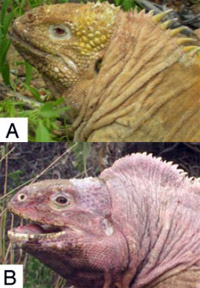
Genus Ctenosauria this are mainly called the spiny tailed iguanas and are native to Mexico and Central America. They are small compared to other iguanas because they can only grow from 5 inches up to 35 inches.
The most outstanding feature of this creature is the large scales on its tail. They are grouped as omnivores which basically feed on fruits and flowers as well as small insects.
Genus Dipsosaurus consists of the dessert iguanas of the Southern America and Mexico. This kind of iguanas is full-bodied with an apex of elevated and expanded scales on its back.
They have cream to white colored bellies and are spotted with white dots and stripe colored tails. They can grow up to 15 inches long with a tail that is as twice as long as its body.
Genus Sauromalus is also known as the Chuckwalla which is a robust herbaceous iguana commonly found in United States and Mexico. These types of iguanas are strict vegetarians they confine themselves with eating only fruits, leaves and flowers.
Chuckwallas have skins that hang loosely on its fat body; they love heat and do not basically moves in the morning until the heat reaches a hundred degrees.
To shove of the extra heat they either change color to reflect the suns heat or hide in the shade. Chuckwallas is also good for captivity as a pet cause they do not move that much.
Lastly the Genus Brachylophus or known as the Fijian banded Iguana which is found in the island of Fiji and Tonga.
Iguanas nowadays are coined as endangered species and illegal possession of any types of iguanas is punishable by law so be sure that if you want an iguana as a pet, have it registered first in a legal process and consult some veterinarians for some advices and guidelines in preparing to adopt an Iguana.
 Albino Iguana – How to Feed Your Albino Iguana?
Albino Iguana – How to Feed Your Albino Iguana?
Iguanas are sensitive creatures; most of them rely on their environment for survival. Having an Albino Iguana as your pet gives you the obligation to properly care for it and make sure that it survives under your captivity.
One of the most crucial factors in an Albino Iguana’s survival is food. So being the owner, you must appropriately feed it with the right food.
Iguanas are scientifically classified as herbivores so green leafy plants should not be in its main diet. Though some people still recommend on feeding iguanas with insects and other animal protein based food.
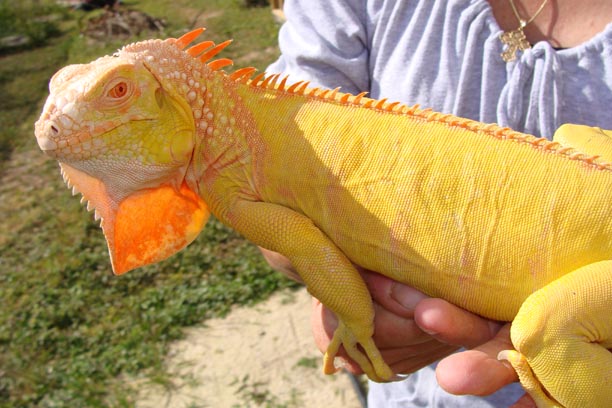
You may have seen iguanas eating insects on televisions and magazines but research studies shows that this thing occurs only by accident. Like for example, when an insect is on a piece of plant. An iguana slowly creeps over to eat it. Then leaf and insect are simultaneously consumed by the reptile.
Experts and veterinarians recommend more vegetables to be fed to your pet and lesser animal protein or insects. This will eventually lead to better physical health.
Albino iguanas also need water, so make sure to provide them with this. Iguanas usually dip their head on the water when drinking, so also make sure to have a tall glass that is full of fresh water. Sometimes they also lick off small water droplets from plants to quench their thirst.
Water should always be available for your iguana and make certain that they are fresh. Never feed your iguana with left over vegetables because this may cause disorders in its digestive system. It will then lead to sickness or even death.
It is highly recommended to feed your iguana every day and regularly. The ideal time for feeding your iguana is early in the morning usually an hour after it is awake. Succeeding feeding all through out the day can also be done but only in small quantity. Never feed your iguana immense amounts of food before sleeping time.
Feeding your Albino Iguana in the morning gives it time to properly digest food before sleeping. In addition, the morning temperature will give your iguana the right environment to properly digest its food.
The amount of food to be given literally depends on the size and bulkiness of your iguana. The main rule in here is to feed your iguana as long as it wants to. This kind of technique will allow you to note how much your iguana can take over one feeding.
Food for your Albino Iguana should be on a shallow bowl which should be made of ceramic, glass or plastic and should be regularly cleaned. The bowl to be used should be sturdy enough to hold your iguana and should not be tipped easily.
Variety of food is also important to make your iguana feel healthy and at home. Iguanas are known to eat a large variety of fruits and flowers in the wild so it is a good idea to also feed them this way while they are in your captivity.
Aside from proper food your iguana should also have the proper lighting and sunshine. Iguanas usually get calcium from the sun rays to help them properly digest their food.
So if you want your Albino Iguana to stay healthy and have a longer life span feed them with the right amount of food and the right kind of food.
 What if a pet iguana turns a yellowish color?
What if a pet iguana turns a yellowish color?
I woke up August 30th to find my Iguana in the back of the cage. She was cold, because the heat bulb burnt out yesterday, so I picked her up and warmed her with my body heat. But when I took a better look at her she wasn’t her green self she was almost completely a pale yellowish color. What is wrong with her?
 Green Iguana – Taking care of the gentle giant
Green Iguana – Taking care of the gentle giant
As it is, with the current recession and everything else going on, more and more people are opting for pets. The reason behind this is simple, you need something or someone to fall back on when you might feel a little down, such is the example of the giant green iguana. One of the natures gentle giants that has suddenly become a craze amongst pet owners.
So what is it that makes this pet so special in the first place? Well, for one thing, they are very nice to look at and while they might not give off the same cuddly features that you normally get from a cat or a dog. But that’s not the only thing, you would think that perhaps its just the fleshy outlook that would keep you happy, its more of the fact that they are lazy giants who spend most of the day basking in the sun.
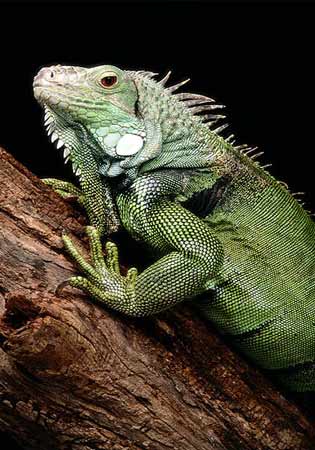
It is just soothing to the eye to see them like that, you know basking in the sun relaxing and feeding off on a lazy fly every now and then, but the thing is that you need to make sure that you are taking adequate care of them as well.
The first thing that you would need to concern yourself with is that you need to have the right kind of temperature in order to keep the giant green iguana happy, the normally preferred temperature for the green Iguana is roughly between 92 and 97 degrees F. The enclosure where you place them should not exceed 85 Degrees-F.
You would also need to make sure that the humidity is also stable. This is one aspect that most pet owners almost always overlook. As it is, the green Iguana absorbs most of the moisture out of the hair, so the more humid it is the better the health of the iguana would be. Keeping that in mind, you also need to make sure that you have a water bowl available within the enclosure this would insure that the iguana gets the right kind of moisture.
Just keep these few things in mind and your green Iguana will stay healthy for the longest term possible. All the best in taking care of the gentle giant.
 what does it mean when my baby pet iguana gets black spots on its head?
what does it mean when my baby pet iguana gets black spots on its head?
when i got this iguana from my dads friend he was bright and healthy. then i put him in a ten gallon tank with lots of vegies and feeding it that and carrots, and also water. i also let it out for excercise. his head turned black.
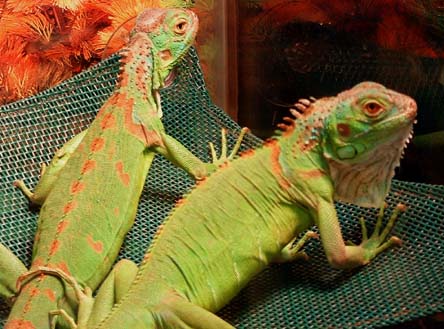
 What is the name of your Iguana?
What is the name of your Iguana?
So I just got a pet Iguana and named it Fulgore. So I was wondering what you other reptile lovers named your pets?

 How stressful are iguanas as pets?
How stressful are iguanas as pets?
My aunt had a huge Iguana living in her house when i was a boy, that thing was humongous at least 5 feet in length, i haven’t talked to my aunt in years and lost contact with alot of my family so here i am asking the web!

 How would i go about taming my pet iguana?
How would i go about taming my pet iguana?
and also how would i know the sex of my iguana? it is still a baby iguana but not quite sure how old it is.
